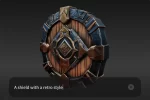
Tripo AI launches new Text-to-CAD API for 3D model generation
3dprintingindustry.com
AI-driven 3D modeling platform Tripo AI has introduced an Application Programming Interface (API) to generate high-quality 3D models from text and image inputs.With this launch, Tripo aims to provide developers with tools to integrate 3D model generation into their applications and services. Designed to enhance user interaction, create immersive environments, and support simulation development, the API offers various features intended to streamline creative workflows.Available through a dedicated web application, Tripos capabilities are also accessible via its API, which is tailored for broader and more customized use cases. For developers looking to streamline their 3D modeling process, Tripos API offers a variety of tools designed to streamline processes ranging from initial drafts to polished, animated models.3D model of a retro style shield. Image via Tripo AI.Key features of Tripos APIOne of the standout features is the APIs ability to generate quick drafts from text and image inputs. Rather than spending hours manually crafting initial concepts, users can produce basic models in a matter of minutes. This approach is aimed at speeding up the prototyping process, allowing developers to explore different designs or perspectives before diving into detailed modeling.Theres also the option to enhance these draft models, moving from rough concepts to high-resolution versions without having to start from scratch. For developers focused on refining their designs, this capability offers a straightforward path to producing polished results.In addition to model generation and refinement, Tripos API supports automated animations, allowing static designs to be brought to life. The idea here is to make presentations and user experiences more dynamic, with minimal effort required on the developers part.Customization and conversion are also on the table. Users can stylize models with creative twists, such as converting them into lego-like or voxel-based versions, to suit various project needs. On top of that, the API supports conversion into widely-used formats like USDZ and FBX, ensuring compatibility across different platforms and applications.Describing its API as a scalable solution, Tripo has also provided a documentation with detailed setup instructions and usage guidelines aimed at ensuring smooth integration and reliable performance.Developments in Text-to-CAD toolsGrowing interest in generative AI has contributed to the expansion of text-to-CAD platforms within the 3D printing sector.For example, Zoo, previously known as KittyCAD, introduced its AI-powered Text-to-CAD tool following a rebranding effort in January 2024. Designed as an open-source platform, the tool uses the KittyCAD design API and ML-ephant machine learning API to convert short text prompts into CAD files, with export options including formats like STL, OBJ, and FBX.The tools effectiveness largely depends on how precisely users describe their intended designs. While vague prompts tend to produce simplistic or inaccurate results, providing clear details about size, shape, and features leads to more accurate and functional models. Zoo is also planning to offer customization options, allowing users to fine-tune the tool using proprietary datasets for tailored applications.A helical gear CAD model generated using Zoos text-to-CAD tool. Image by 3D Printing Industry.Another contribution came from GPU manufacturer Nvidia developing its Magic3D text-to-3D model tool in parallel with Googles DreamFusion and Physna Inc.s generative AI prototype for creating 3D models and scenes.According to a research paper, the tool uses a two-step approach where it first generates a basic, low-resolution model, which is then refined to achieve higher resolution. Magic3D also supports prompt-based editing of 3D meshes. After uploading a base prompt and a low-resolution model, users can alter the text input to modify the resulting 3D model.What3D printing trendsshould you watch out for in 2025?How is thefuture of 3D printingshaping upTo stay up to date with the latest 3D printing news, dont forget to subscribe to the 3D Printing Industry newsletter or follow us on Twitter, or like our page on Facebook.While youre here, why not subscribe to our Youtube channel? Featuring discussion, debriefs, video shorts, and webinar replays.Featured image shows a 3D model of a retro style shield. Image via Tripo AI.
0 Comentários
·0 Compartilhamentos
·42 Visualizações


